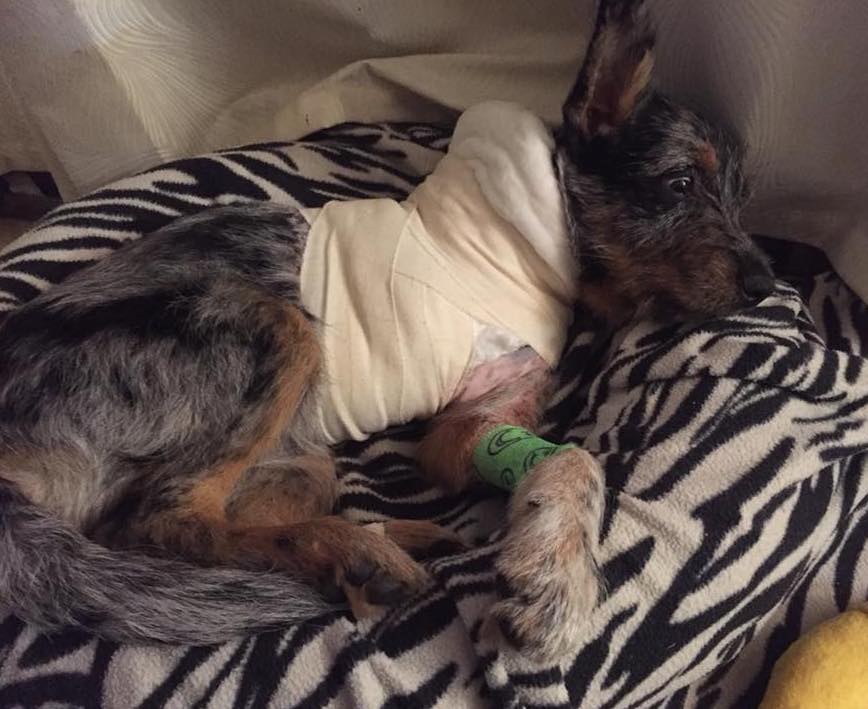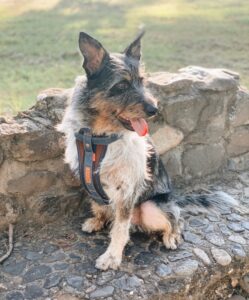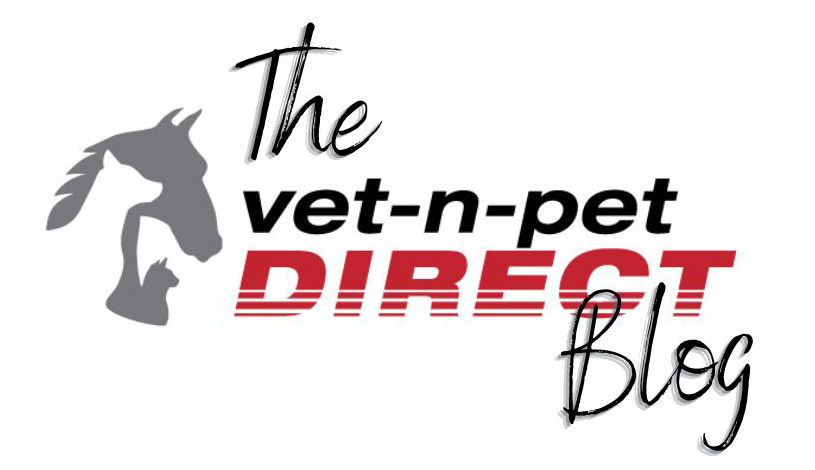Lots of people ask similar questions upon finding out their dog or cat has to have an amputation so I thought it might be handy to do a “Becoming a Tripawd Parent 101” post. I’m a qualified vet nurse with over a decade in the industry and I’m a tripawd mum so I have experience on both sides of the process. Hopefully this information can help answer some questions and make the process less stressful for both pet and parent.
I will say up the top to ???? ???? ???’? ?????? ????? ??? ???????? over anything you read on the internet – if you’re not happy with your vet go and get a second opinion from another vet. I may be a vet nurse but if what I have said contradicts what your vet has told you, please take their advice over mine!
So your vet has suggested amputation
It can be overwhelming for any pet owner to hear this news. It’s a big decision to make so it’s ok to feel whatever you are feeling. Most people’s first concern is for the welfare of their pet after becoming a tripawd. Rest assured they will still be able to run, swim, play, hike, jump, dig and do all the things any other dog can do!
What can you do to prepare for surgery and recovery?
- A crate or playpen with lots of soft bedding will be good to keep them confined and safe from other pets or kids while they’re recovering.
- Some non slip mats can help give traction when they start walking if you have hard slippery floors.
- An old shirt or doggy shirt for them to wear to cover the bandage and keep it clean.
- You can get soft or inflatable elizabethan collars (cone of shame) which can be more comfortable to wear than the plastic ones, like the Kong Cushion Collar.
- I recommend getting some enrichment toys especially for young dogs or intelligent active breeds. As they start to feel better this is invaluable for keeping their minds occupied when they have to sit still.
- A harness suitable for three legged dogs if you have a front leg amputation – the Ruffwear Front Range Harness and the EzyDog Convert Harness seem to be the most popular. I actually use a chest plate harness which I stitched for the chest plate to stay in the right place as I found it was easier to put on for my dog (he has a lot of anxiety and behaviour stuff so he was funny about having things on him – the point is, find what works for you and your pet!)
- Some training pads to put on the floor if you’re unable to get them outside to go to the toilet
- If you’re concerned about anxiety have a chat to your vet about using Zylkene or Adaptil. They are very effective and I have had dozens of clients who’ve had huge success using them to help with anxiety in pets.
- Have plenty of your dog’s food and training treats on hand – and some easy meals and treats for yourself!
What happens for my pet on the day of their surgery after I drop them off?
I can’t speak for all practices but from my clinical experience this is generally the standard procedure of the amputation process.
Once arriving and being checked in to the clinic pets are put into a hospital bed to settle in. They’re given anaesthetic medication which can make them a little sleepy so it makes them more comfortable. Your vet may run some blood tests and do some more x- rays or other imaging but they will discuss that with you first. The vet and vet nurses will put a cannula in your pet’s leg while giving your pets lots of cuddles and reassuring them. If you have consented to giving fluids (which I highly recommend if your vet thinks its suitable) this is when they will start the drip. They will then administer an anaesthetic and your pet will go to sleep.
While your pet is under anaesthetic they will be on heated pads designed to maintain optimum body temperature. They will have a tube in their airways to keep them breathing and the vet nurses will monitor your pet’s temperature, heart rate, breathing rate and blood pressure. A vet nurse will clip the hair off the surgical site (to avoid contamination from fluff) then thoroughly clean the skin around the surgical site. The surgical team will scrub up and don their gowns, masks and hats and while their triage team move your pet into the sterile surgical room. A vet nurse will monitor your pet the entire way through their surgery and adjust the anaesthetic gas if they need to.
Once the surgery is complete they will take your pet to a recovery area where a vet nurse will stay with them, once your pet is breathing ok on their own they will take out the breathing tube, unless your pet is a brachycephalic breed this will all happen before they wake up. Dogs with shorter faces (pugs, bulldogs etc) have more risk of airways collapsing so the breathing tube will remain in as long as possible. A vet nurse will continue to monitor your pet as they wake up and a vet will check them over again once they’re awake. They will then be taken back to a quiet hospital bed with a heat pack and a blanket where they usually just sleep in between checks from the vet team until you come to take them home!
Going to pick your dog up post surgery
Many vets will send patients home with written post surgery instructions. If they haven’t given you a care sheet just ask them to write you a list or jot some notes down. It can be hard to remember everything because it’s a stressful time so it’s good to have a list to refer to. Ask as many questions as you want, that’s what your veterinary care team is there for! Make sure you’re clear on what medications your pet has, when they have to have them and how to administer them.
Getting home post op.

- Put your pet in their crate/playpen with their bedding and try to get them comfortable. Make sure they’re warm as it can take a little while after anaesthetic to regulate body temperature. Some people say their pets look really sad – remember that they may still be metabolising anaesthetic and will be on some heavy duty pain killers so they may not be sad just a bit dopey.
- Generally it’s suggested to offer your pet a small meal (not too much food at once) the night after surgery but again please take your vet’s advice on this.
- They may whimper a bit, this is normal and can be that they’re a bit trippy from pain meds. They may also be cold or hot, need to go to the toilet or just need a bit of reassurance. It can be really heartbreaking to see them like this. Even though I have taken 1000’s of animals through surgery and post op it was still really hard for me to see my pup like this!
- Try to stay calm and reassuring when you’re around them. I sat with my dog and read the book I was reading aloud to him. A calming voice can help a lot. If they’re struggling to settle and you’ve ruled out pain, toilet, food etc, I find that if you just sit calmly and talk to them they will feed off your energy and eventually calm down too. This is where anxiety medications like Zylkene or Adaptil could come in handy as well.
- If you’re concerned that your pet is in too much pain don’t hesitate to contact your vet or an after hours vet for advice.
- Don’t forget to look after yourself on the first night too, let yourself have a cry if you need to and take some deep breaths when you’re feeling overwhelmed. Remember this is the worst of it and it will get much better!
The recovery weeks
- Chewing bandages/licking near the surgical site: Get that elizabethan collar on (cone of shame). They can take some getting used to them and be a little uncomfortable but it’s better than an infected wound! Give your dog something distracting to do so they’re not thinking about it – like a pigs ear or enrichment toy.
- Swelling/redness/discharge: Call your vet! Some level of this is normal but that’s something that can only be determined by your veterinary professional. I can’t stress this enough!
- If they’re struggling to walk: You can use an old towel like a sling to help them balance. This video tutorial found here might help you to create a sling and get your pet up and moving.
- Within the first 24-48 hours after surgery your dog should be eating, drinking, pooping and weeing normally, if any of this isn’t happening contact your vet. House trained dogs may hesitate to wee on training pads inside so this is where it’s handy to have that shirt to put over the bandages to take them outside to go to the toilet.
- If your dog just wants to sleep and rest, that’s ok as long as they’re doing all of the above. You may find they’re pretty sleepy for a while but it’s good for them to be still while they recover. Now is the perfect time to curl up together and watch your favourite movies or read your dog a book!
- You will probably be amazed at how quickly they get up and about, often then it brings another challenge which is keeping them still! This is where those enrichment toys come in handy. You can mix kibble with dog safe peanut butter and put that inside (don’t stuff them too tight or it’s too tricky for them to get the delicious goods out). Frozen vegetables or pureed sweet potato/pumpkin is also great. The goat horns can keep them entertained for hours and if you’re giving them bully chews or pigs ears make sure you’re keeping an eye on them as they can be a choking hazard. If you don’t have any enrichment toys, grab that old towel, lay it flat and sprinkle kibble in it then roll it up and sprinkle some more kibble as you roll – this is a good nose game for them and doesn’t involve too much movement. The more they can rest the better!
- As they are wanting to be more active, resist the temptation to let them run around. As much as it’s the most joyful thing seeing your pet getting comfortable with their 3 legs they really need to stay still as long as your vet has recommended!
Long term care

- Once recovered our three legged pets can live an almost normal life just like before.
- Pets with 3 legs need to be kept at a normal weight (if not on the low end of normal) to reduce the stress on their remaining joints. Unfortunately having 3 legs does increase the risk of cruciate ligament and patella tears. I take my dog in for regular weigh ins and have discussed his optimal weight range with his vet so we can make sure he stays within that.
- Regular exercise of course! Walks and playing! My dog absolutely loves to swim and if your tripawd likes to swim too this is great for them as it keeps them fit without impacting their joints. You can get doggy life jackets which is great as a safeguard when swimming. Tripawds can still do agility and flyball, most clubs are happy to modify any jumps for Tripawds. My tripawd is an absolute speed demon when it comes to weaving poles.
- Using a joint health supplement like 4Cyte or Rosehip Vital can be beneficial. These are great to use for prevention not just treatment.
- Avoid jumping and stairs as much as you can.
I’d like to reiterate again how important it is to speak to your veterinary professional (or an after hours vet) if you have concerns. Also remember that every pet is different and what may work for one pet won’t work for all.
I originally wrote this article for the Facebook Group Tripawds Australia to help fellow paw parents and their pets on their tripawd journey. This group (and I am sure there are others out there) are fantastic for sharing experiences and tips on life with a three-legged pet, join one if you can.
Good luck to all the tripawd paw-rents, wishing your pets a speedy recovery and I hope it won’t be long before you can enjoy seeing them thriving on three legs!
🙂
Aria
